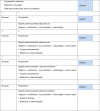Daily baseline skin care in the prevention, treatment, and supportive care of skin toxicity in oncology patients: recommendations from a multinational expert panel
- PMID: 24353440
- PMCID: PMC3862511
- DOI: 10.2147/CMAR.S52256
Daily baseline skin care in the prevention, treatment, and supportive care of skin toxicity in oncology patients: recommendations from a multinational expert panel
Abstract
Skin reactions due to radiotherapy and chemotherapy are a significant problem for an important number of cancer patients. While effective for treating cancer, they disturb cutaneous barrier function, causing a reaction soon after initiation of treatment that impacts patient quality of life. Managing these symptoms with cosmetics and nonpharmaceutical skin care products for camouflage or personal hygiene may be important for increasing patient self-esteem. However, inappropriate product choice or use could worsen side effects. Although recommendations exist for the pharmaceutical treatment of skin reactions, there are no recommendations for the choice or use of dermatologic skin care products for oncology patients. The present guidelines were developed by a board of European experts in dermatology and oncology to provide cancer care professionals with guidance for the appropriate use of non-pharmaceutical, dermocosmetic skin care management of cutaneous toxicities associated with radiotherapy and systemic chemotherapy, including epidermal growth factor inhibitors and monoclonal antibodies. The experts hope that these recommendations will improve the management of cutaneous side effects and hence quality of life for oncology patients.
Keywords: cancer; chemotherapy; consensus; cosmetic; dermatological toxicity; folliculitis; radiotherapy; skin care; supportive care; xerosis.
Figures
References
-
- Robert C, Soria JC, Spatz A, et al. Cutaneous side-effects of kinase inhibitors and blocking antibodies. Lancet Oncol. 2005;6(7):491–500. - PubMed
-
- Segaert S, Chiritescu G, Lemmens L, Dumon K, Van Cutsem E, Tejpar S. Skin toxicities of targeted therapies. Eur J Cancer. 2009;45(Suppl 1):295–308. - PubMed
-
- Perez-Soler R, Delord JP, Halpern A, et al. HER1/EGFR inhibitor-associated rash: future directions for management and investigation outcomes from the HER1/EGFR inhibitor rash management forum. Oncologist. 2005;10(5):345–356. - PubMed
-
- Lacouture ME, Lai SE. The PRIDE (Papulopustules and/or paronychia, Regulatory abnormalities of hair growth, Itching, and Dryness due to Epidermal growth factor receptor inhibitors) syndrome. Br J Dermatol. 2006;155(4):852–854. - PubMed
-
- Agero AL, Dusza SW, Benvenuto-Andrade C, Busam KJ, Myskowski P, Halpern AC. Dermatologic side effects associated with the epidermal growth factor receptor inhibitors. J Am Acad Dermatol. 2006;55(4):657–670. - PubMed
LinkOut - more resources
Full Text Sources
Other Literature Sources


